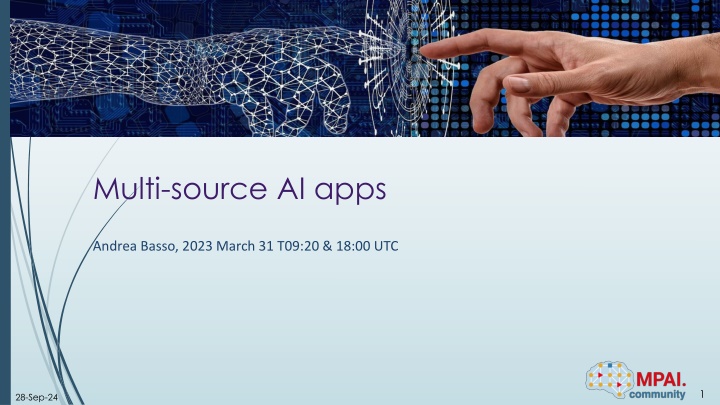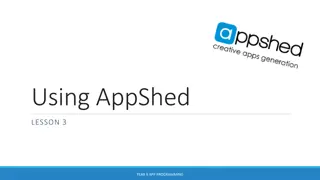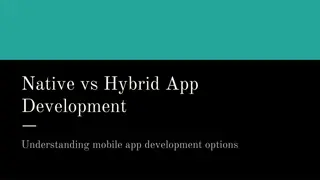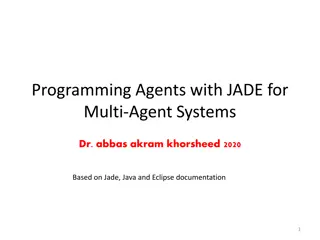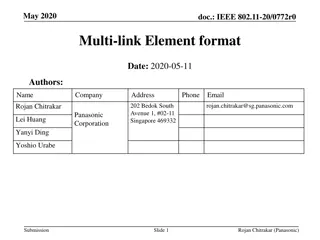Streamlining AI Development with Multi-Source AI Apps Framework
An AI Framework (AIF) is essential for creating, executing, and updating high-complexity AI solutions through interconnecting multi-vendor AI modules. The MPAI approach emphasizes standardization, enabling access to modular AI components, promoting innovation, and enhancing the user experience. With features like independent operating systems, component-based architecture, and support for machine learning, the MPAI-AIF framework offers a versatile solution for developing advanced AI applications.
Download Presentation

Please find below an Image/Link to download the presentation.
The content on the website is provided AS IS for your information and personal use only. It may not be sold, licensed, or shared on other websites without obtaining consent from the author.If you encounter any issues during the download, it is possible that the publisher has removed the file from their server.
You are allowed to download the files provided on this website for personal or commercial use, subject to the condition that they are used lawfully. All files are the property of their respective owners.
The content on the website is provided AS IS for your information and personal use only. It may not be sold, licensed, or shared on other websites without obtaining consent from the author.
E N D
Presentation Transcript
Multi-source AI apps Andrea Basso, 2023 March 31 T09:20 & 18:00 UTC 1 28-Sep-24
An AI Framework (AIF) is needed An AI framework enables creation, execution, composition and update of AIM- based workflows for high-complexity AI solutions interconnecting multi-vendor AIMs trained to specific tasks, operating in the standard AI framework and exchanging data in standard formats. It will benefit various actors: Technology providers will be able to offer their conforming AI tecnologies to an open market Application developers will find on the open market for their applications need Innovation will be fueled by the demand for novel and more performing AI components Consumers will be offered a wider choice of better AI applications by a competitive market Society will be able to lift the veil of opacity from large, monolithic AI-based applications. 2 28-Sep-24
MPAI approach to standardisation AI AI Open market of components with standardises functions and Interfaces, competing in performance. Module (AIM) Module (AIM) Outputs Inputs User Agent AI Workflow (AIW) AI AIM Storage AI Module (AIM) Module (AIM) Controller Global Storage MPAI Store Communication Access MPAI-AIF enables independently sourced AI Modules having standardised interfaces to be executed in an environment with standardised APIs. 3 28-Sep-24
AIF Components Access: provides access to static or slowly changing data such as domain knowledge data, data models, etc. AI Module (AIM): a data processing element receiving Inputs and producing Outputs according to its Function. An AIM may be an aggregation of AIMs. AI Workflow (AIW): an organised aggregation of AIMs implementing a Use Case Communication: connects the Components of an AIF. Controller: Exposes three APIs: i. AIM API through which modules can register, communicate and access the rest of the AIF environment and can be started, stopped and suspended ii. User API through which the user or other Controllers can perform high-level tasks (e.g., switch the Controller on and off, give inputs to the AIW through the Controller). iii. MPAI Store API to enable communication between the AIF and the Store. e. May run one or more AIWs. Global Storage: stores data shared by AIMs. Internal Storage: stores data of the individual AIMs. MPAI Store: stores Implementations for users to download. User Agent: The Component interfacing the user with an AIF through the Controller 4 28-Sep-24
Features of MPAI-AIF (V1) 1. 2. 3. 4. 5. Independent of the Operating System. Component-based modular architecture with specified interfaces. Interfaces encapsulate Components to abstract them from the development environment. Interface with the Store enables access to validated Components. Component can be Implemented as: 1. Software only, from MCUs up to HPC. 2. Hardware only. 3. Component system features are: Hybrid hardware-software. 6. 1. Execution in local and distributed Zero-Trust architectures. 2. Possibility to interact with other Implementations operating in proximity. 3. Direct support to Machine Learning functionalities. 5 28-Sep-24
MPAI AIF and Security Need to provide support for Multiple technology providers with potentially different security requirements Multiple users with potentially different security requirements Application developers shall be able to select the application s security either or both by: Level of security that includes a defined set of security features for each level. Developer-defined security, i.e., a level that includes a developer-defined set of security features. MPAI-AIF V2 6 28-Sep-24
MPAI-AIF V2 Reference Model (WD) AI AI Module (AIM) Module (AIM) Outputs Inputs User Agent AI AIM/AIW Storage (non secure) Module (AIM) AI AIM/AIW Storage (secure) Module (AIM) Controller SAL Communi- cation Global Storage MPAI Store Attestation Service Encryption Service Communica- tion Service Access AIM Model Service AIM Storage Service AIM Security Engine Trusted Services 7 28-Sep-24
Features of MPAI-AIF (V2)/1 1. High-level implementation-independent Trusted Services API. 2.The AIF Trusted Services shall be able to use hardware and OS security features already existing in the hardware and software of the environment in which the AIF is implemented. 3.Security is currently supported at AIF level, in line with current practices, specifically in the following configuration: 1.There is only one an AIW containing only one AIM which may in its turn be a Composite AIM. 2.The AIM Storage is secure vis- -vis an external attacker, but the individual AIMs have access to to AIF Components. 3.Communication can be made secure by adoptina secure communication protocol. 4.Application developers shall be able to select security of their application by using specific security services. 8 28-Sep-24
Features of MPAI-AIF (V2)/2 1. Controller 1. The AIMs in the AIW trust each other and communicate without special security concerns. 2. Communication among AIMs in the Composite AIM remains non-secure. 3. Communication with the MPAI-Store and the User Agent is secure (Authentication, Attestation, and Encryption). 4. Accesses Communication, Global Storage, Access and MPAI Store via Trusted Services API. 2. AIM/AIW Storage 1. Secure Storage functionality is provided through key exchange. 3. Definition of a Secure Abstraction Layer (SAL) 4. The AIW/AIMs call the SAL via API. 1. The controller is split in two parts (working assumption): 2. the frontend in the non-secure code part 3. the backend in the secure code part 9 28-Sep-24
Join MPAI Share the fun Build the future! We look forward to your participation in this exciting project! https://mpai.community/ 10 28-Sep-24
